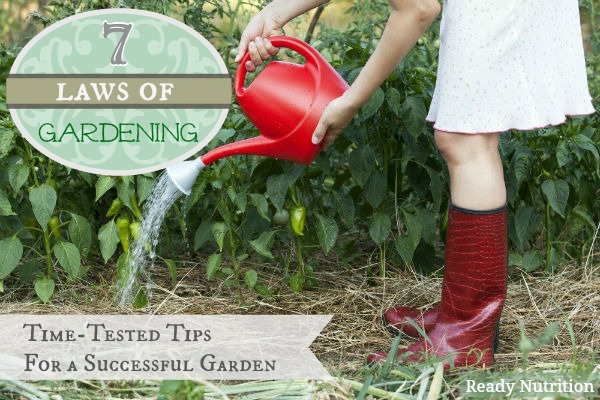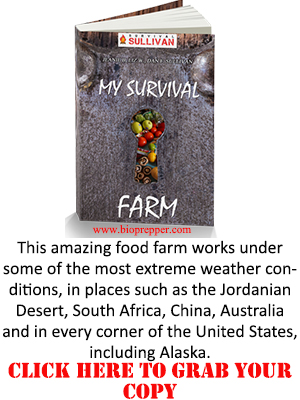We all have the best of intentions in the beginning of summer. We plan on spending the season growing a beautiful lush garden. As the summer drags on, avoiding the heat becomes the top priority.

From the neglect, your garden suffers. The plants may not be thriving, there may be bug infestations, or root rot. Inevitably, if there are enough issues, you give up altogether and call it a summer. What you may not realize is there are laws that you must follow to ensure your plants have the best environment to thrive in. These gardening laws are essential in giving your plants a fighting chance at giving you a big harvest.
7 Laws For Successful Gardening
1. Start with good quality seeds. Seed quality plays an important role in a successful garden. As such, it is important to know seed characteristics such as trueness to variety, germination percentage, purity, vigor, and appearance are important to farmers planting crops and to homeowners establishing lawns and gardens. Further, growing heirloom seed varieties will ensure you can collect the seeds for subsequent harvests.
2. Feed the soil. Your plants need nutrients in order to grow healthy and produce fruit and vegetables. Ensuring they have these present in the soil will save you time and money on fertilizer.
I love incorporating the lasagna-style or sheet mulch gardening with the square foot gardening method. This is the best opportunity to introduce compostables to the soil. Composting is a great way to provide some added nutrients and condition the soil. Fertilizers will give the plants just what they need to produce healthy fruit. Building your own composter can help you make use of any organic materials, as well as getting onto the journey to self-sustainment. I also add soil amenders to make my soil really healthy. Some of the amenders I use are:
You can purchase these items at a garden store, online or find a local source on Craigslist. I recently purchased 60 pounds of earthworm castings for twenty-five dollars. Not a bad deal, if you ask me.
3. Balance the amount of sunlight with the ideal temperatures. Who knew gardening was a balancing act. But in order to get a good harvest, you have to balance to amount of sunlight your plan gets with the ideal temperature. If your garden or patio area receives full sun all day long, it can wreak havoc on your gardening endeavors. Keep in mind that plants need at least six to eight hours of sunlight to grow to their maximum potential. That said, the temperature plays a key role in plant health. Keeping plants between 70-90 degrees F will help the plants grow to their potential. Transplants especially will benefit from shade cloth. There are different percentages of shade cloth ranging from 25% – 70% or more. This will allow you block out the heat from the sun and help the plant thrive. All you need to do is drape the cloth over a support structure. Many gardeners use ladders, pvc hoop-style structures, or purchase products specifically manufactured to support shade cloth. Here are plans to build a shape canopy for the garden using pvc pipe. Read more here.
4. Regular waterings will prevent plant stress. Having an irrigation system in place with a timer will be less work for you and will ensure your plants are getting a balanced amount of moisture at each watering. This also will help you not over-water your plants which can be just as bad as not watering at all.
5. Protect the roots with mulch. Mulching the roots is a trade secret many successful gardeners use to protect the plant’s delicate root structures and prevent weeds from growing. You can use fallen leaves, straw, wood chips or newspaper to shade the roots. This will keep the roots moist and not stress the plant out during the warmest parts of the day. As well, the natural mulch will compost down over time and help your soil in the process.
6. Talk to your plants. I know that I’m going to get some comments about how crazy I am for listing this, but I believe in talking to your plants. While there is no evidence to suggest that plants respond to affection, some plants do have a limited ability to communicate with one another. Though plants lack the ability to receive and process sound waves, evidence suggests that some plants can communicate with each other through the use of chemical signals. Additionally, vibrations that travel through the soil or in the air may have an effect on plant growth. It may be possible for plants to pick up on the vibrations created by human speech and maybe even by the chemical signals that humans release without knowing it.
7. Give your plants some friends. Many use companion planting in organic gardens to let nature do most of the work instead of chemicals. In theory, using this type of gardening, essentially creates an agroecosystem. Nothing goes to waste and everything is interdependent. The bi-products of these plants (dead heads, frail looking plants, etc.) can be used as soil conditioners. This makes for great efficiency and good use of space. Read more about which companion plants to use in vegetable, fruit and herb gardens.
Above all, visit your garden regularly. When you spend time in the garden, you will be less likely to neglect it. By following these simple laws of gardening, you can have a successful garden, year after year.
This information has been made available by Ready Nutrition
What to read next:
DIFFERENT COMPOST MAKING TECHNIQUES (AND THE ADVANTAGES OF EACH)
STORE VEGGIES FOR LONG TERM STEP-BY-STEP
HOW TO PLANT A QUICK AND EASY GARDEN IN BAGS OF SOIL WITHOUT DIGGING
WATERING TOMATOES: WHEN & HOW – 5 PRO TIPS
HOW TO GROW TRUFFLES IN 7 EASY STEPS AND MAKE A BIG PROFIT
HOW TO BUILD AN INDOOR HYDROPONIC VEGETABLE GARDEN
Want to be as self-sufficient as possible? Want to master all the lost skills our grandfathers had? Then you really need this amazing step-by-step guide. It is called The Lost Ways and it contains all the knowledge of our forefathers.
Here’s just a glimpse of what you’ll find in The Lost Ways:
From Ruff Simons, an old west history expert and former deputy, you’ll learn the techniques and methods used by the wise sheriffs from the frontiers to defend an entire village despite being outnumbered and outgunned by gangs of robbers and bandits, and how you can use their wisdom to defend your home against looters when you’ll be surrounded.
Native American ERIK BAINBRIDGE – who took part in the reconstruction of the native village of Kule Loklo in California, will show you how Native Americans build the subterranean roundhouse, an underground house that today will serve you as a storm shelter, a perfectly camouflaged hideout, or a bunker. It can easily shelter three to four families, so how will you feel if, when all hell breaks loose, you’ll be able to call all your loved ones and offer them guidance and shelter? Besides that, the subterranean roundhouse makes an awesome root cellar where you can keep all your food and water reserves year-round.
From Shannon Azares you’ll learn how sailors from the XVII century preserved water in their ships for months on end, even years and how you can use this method to preserve clean water for your family cost-free.
Mike Searson – who is a Firearm and Old West history expert – will show you what to do when there is no more ammo to be had, how people who wandered the West managed to hunt eight deer with six bullets, and why their supply of ammo never ran out. Remember the panic buying in the first half of 2013? That was nothing compared to what’s going to precede the collapse.
From Susan Morrow, an ex-science teacher and chemist, you’ll master “The Art of Poultice.” She says, “If you really explore the ingredients from which our forefathers made poultices, you’ll be totally surprised by the similarities with modern medicines.” Well…how would you feel in a crisis to be the only one from the group knowledgeable about this lost skill? When there are no more antibiotics, people will turn to you to save their ill children’s lives.
And believe it or not, this is not all…
Table Of Contents:
Making Your Own Beverages: Beer to Stronger Stuff
Ginger Beer: Making Soda the Old Fashioned Way
How North American Indians and Early Pioneers Made Pemmican
Spycraft: Military Correspondence During The 1700’s to 1900’s
Wild West Guns for SHTF and a Guide to Rolling Your Own Ammo
How Our Forefathers Built Their Sawmills, Grain Mills,and Stamping Mills
How Our Ancestors Made Herbal Poultice to Heal Their Wounds
What Our Ancestors Were Foraging For? or How to Wildcraft Your Table
How Our Ancestors Navigated Without Using a GPS System
How Our Forefathers Made Knives
How Our Forefathers Made Snow shoes for Survival
How North California Native Americans Built Their Semi-subterranean Roundhouses
Our Ancestors’Guide to Root Cellars
Good Old Fashioned Cooking on an Open Flame
Learning from Our Ancestors How to Preserve Water
Learning from Our Ancestors How to Take Care of Our Hygiene When There Isn’t Anything to Buy
How and Why I Prefer to Make Soap with Modern Ingredients
Temporarily Installing a Wood-Burning Stove during Emergencies
Making Traditional and Survival Bark Bread…….
Trapping in Winter for Beaver and Muskrat Just like Our Forefathers Did
How to Make a Smokehouse and Smoke Fish
Survival Lessons From The Donner Party
Get your paperback copy HERE
CHECK OUR survival and prepping solutions
If you found this article useful, please like our Facebook page and stay up to date with the latest articles.
Tess Pennington is the author of The Prepper’s Blueprint, a comprehensive guide that uses real-life scenarios to help you prepare for any disaster. Because a crisis rarely stops with a triggering event the aftermath can spiral, having the capacity to cripple our normal ways of life. The well-rounded, multi-layered approach outlined in the Blueprint helps you make sense of a wide array of preparedness concepts through easily digestible action items and supply lists.
Tess is also the author of the highly rated Prepper’s Cookbook, which helps you to create a plan for stocking, organizing and maintaining a proper emergency food supply and includes over 300 recipes for nutritious, delicious, life-saving meals.
Visit her web site at ReadyNutrition.com for an extensive compilation of free information on preparedness, homesteading, and healthy living.

